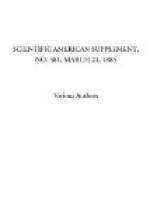The motion for working the top detaching, the leather, or the piecing roller, as it is variously called, has also been improved. The ends of this roller are always carried on the top of two levers that are oscillated by a connecting rod attached to their bottom ends. In the new motion the connecting rod is dispensed with, and one joint saved. The joint that remains is at the foot of the levers that carry the leather roller. This joint is constructed so that it may be easily altered, and by its means one of the most delicate settings of the combing machine, viz., that of the leather roller, may be made with greater readiness than with the old system. Further, from the mode of mounting these rollers another advantage is gained in the facility of setting them. In setting with the old arrangement, only one end of the roller is adjusted at a time; in the new, the adjustment sets the ends of two rollers. With regard to the leather roller also, it was found that as the round brass tubes in which its ends revolved had very little wearing surface, they got worn into flats on the outside, and thus worked inaccurately. In the machine under notice this defect is remedied. The tubes are made square on the outside, and having ample bearing surface they keep their adjustment perfectly.
On the top of the detaching roller is a large steel fluted roller carried at each end by a small arm called a “horse tail.” In the original machine this roller simply kept its place upon the detaching roller by its weight, and when the machine came to be run at high speeds it was found that owing to its lightness the contact thus obtained was not reliable, the flutes or ribs of the roller slipping upon those




